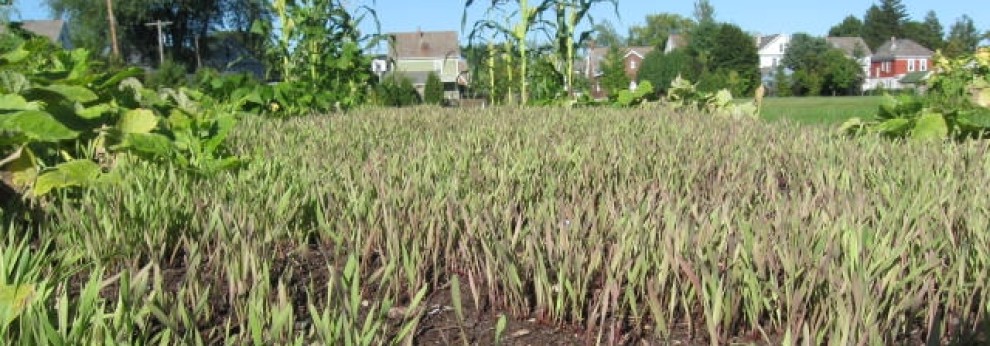 Sixth graders at Myers Middle School pulled a chunk of Purple loosestrife from soil around the Vegetable Project’s garden at the school on Thursday. The effort — and it was hard work — may not actually do much to curb the spread of the invasive plant that’s easy to spot along roadsides this time of year.
Sixth graders at Myers Middle School pulled a chunk of Purple loosestrife from soil around the Vegetable Project’s garden at the school on Thursday. The effort — and it was hard work — may not actually do much to curb the spread of the invasive plant that’s easy to spot along roadsides this time of year.
We’re okay with that, however, having organized a two-day Invasive Species Workshop and embedding it within a weeklong Transition Camp for students who are entering middle school after graduating from elementary school back in June. The workshop’s purpose was really about  teaching and learning – about invasive species and their threat to stable ecosystems – and building some awareness of an environmental challenge just outside the school building and maybe even, if we were really lucky, instilling some sense that the environment is worth caring about.
teaching and learning – about invasive species and their threat to stable ecosystems – and building some awareness of an environmental challenge just outside the school building and maybe even, if we were really lucky, instilling some sense that the environment is worth caring about.
We organized the workshop around a couple of teaching and learning ideas that animate many of our efforts: surely starting with the value of doing and touching and tasting and experiencing, and doing all of that outdoors to the  extent possible. Field trips are great, but don’t overlook the ones that don’t require permission slips and paying for buses. Exploring something in depth is sometimes way more meaningful than the breadth of material that we see taught in so many classes. Thus, our focus for two days on just two terms, invasive species and ecosystem.
extent possible. Field trips are great, but don’t overlook the ones that don’t require permission slips and paying for buses. Exploring something in depth is sometimes way more meaningful than the breadth of material that we see taught in so many classes. Thus, our focus for two days on just two terms, invasive species and ecosystem.
Oh, and here’s another idea that certainly isn’t original: Not everything that counts can be measured. Just imagine trying to measure whether we built awareness in two days of an environmental challenge and instilled some sense that the environment is worth caring about.
The structure of our workshop was actually quite simple: On the first day, we gave kids a clipboard and  an aerial photo of the area near our garden where we see more Purple loosestrife year after. We asked them to mark on the photo where they found the plant. And we talked with them about our two focus terms while they did that. And then the next day, we pulled plants from the ground and placed stakes with colorful ribbons where plants came out. Maybe the stakes will help us determine next August what we accomplished this week.
an aerial photo of the area near our garden where we see more Purple loosestrife year after. We asked them to mark on the photo where they found the plant. And we talked with them about our two focus terms while they did that. And then the next day, we pulled plants from the ground and placed stakes with colorful ribbons where plants came out. Maybe the stakes will help us determine next August what we accomplished this week.
We created our workshop around Purple loosestrife and held it in August because the plant is quite visible around our garden at this time of year. But interestingly, it is  hardly the only invasive species issue at Myers. Phragmites are aggressively pushing out native cattails. We see splotches of Queen Anne’s lace, garlic mustard and Oriental bittersweet. And four ash trees, which Emerald ash borers are destroying near and far, seem healthy – so far.
hardly the only invasive species issue at Myers. Phragmites are aggressively pushing out native cattails. We see splotches of Queen Anne’s lace, garlic mustard and Oriental bittersweet. And four ash trees, which Emerald ash borers are destroying near and far, seem healthy – so far.
Would all of this offer a rich ambitious teaching opportunities, well beyond what we tried to tackle in 45 minutes with kids one day and then 30 minutes the follow day? Depth over breadth certainly argues for giving the 50 students we engaged a chance to learn more about what we started sharing with them. It would be especially great to return to the physical space we worked in to make follow-up observations. Assembling an ambitious project, however, in a school where educators already feel overwhelmed with demands placed on them is not easy.
–Bill Stoneman



